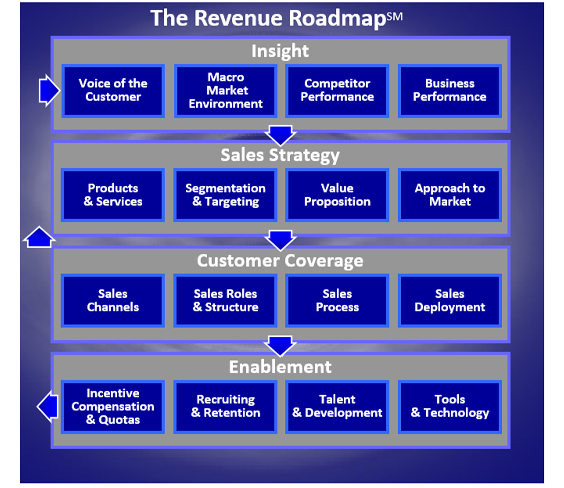The Revenue Roadmap: Customer Coverage And Sales Enablement

This is a continuation of our blog series, Designing Your 2018 Sales Compensation Plan. Want to begin at the beginning? Click here.
“I like to say that the comp plan is the caboose, not the engine,” says Doug Holland, director of HR and compensation at Manpower. “Compensation should never be driving the strategy. The strategy drives the compensation. It’s incredible, especially in times of stress, how that message can kind of get lost.”
Below are the third and fourth parts of the framework, The Revenue Roadmapsm, which shapes your sales compensation programs and connects it to your strategy.
Customer Coverage defines how the organization will use its channels, roles, processes, and resources to go to market. Customer coverage includes sales channels (third party resellers, referral partners, retailers, or company sales force); sales roles; sales processes; and sales deployment. Sales channels and sales roles integrate with the processes for working with customers. In fact, the best customer coverage models are built from the customer’s buying process with a sales process and roles that reflect how the customer prefers to work. Sales processes lay out the common approaches for how the sales team identifies prospects, qualifies opportunities, develops solutions, manages the momentum, closes the sale, and implements the product or service for the customer.
Enablement supports all of the upstream disciplines within Customer Coverage, Sales Strategy, and Insight. Enablement includes areas such as incentive compensation and quotas, which aligns sellers to the sales strategy. It includes recruiting and retention, which define the current inventory of talent and determine how the organization is going to attract and retain the right talent for the long term. Training and development builds the capabilities of the organization for people currently in their jobs and in junior roles that will progress into key sales roles. Tools and technology provide leverage by enhancing the effectiveness of gaining insight and implementing the organization’s decisions around sales strategy, customer coverage, and enablement.
Jeff Connor, chief growth officer for ARAMARK, a global provider of food services, facilities management, and uniforms, is involved in the sales compensation process. “People confuse incentives with alignment, and they jump to incentives as the answer, as opposed to the hard work of alignment,” he says. “When you look at The Revenue Roadmapsm, sales and incentive compensation is at the bottom. In my experience, when you talk sales compensation everybody wants to just take big business objectives and assign incentives, as if the sales people will go after anything where there’s a buck.
“In reality, anybody who’s every worked on sales comp knows it doesn’t operate like that. The alignment work – getting the correct insight, aligning it to the sales strategy – has to happen first. The last think you do at the end of the day is work on the incentive plan. Confusing incentives for alignment happens all the time. People just go right to the ideas without understanding context. I think this idea of alignment is really important.”
For questions, email Mark Donnolo at Mark.Donnolo@SalesGlobe.com.

We Rethink Sales…
SalesGlobe is a data-driven, creative problem-solving firm for sales that solves the most challenging problems.



